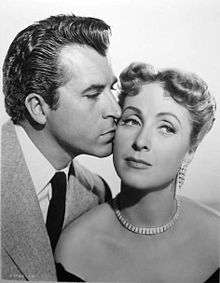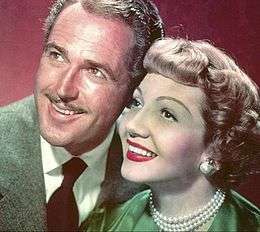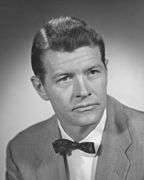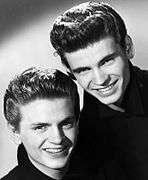Hairstyles in the 1950s

The 1950s was a decade known for experimentation with new styles and culture. Following World War II and the austerity years of the post-war period, the 1950s were a time of comparative prosperity, which influenced fashion and the concept of glamour. Hairstylists invented new hairstyles for wealthy patrons. Influential hairstylists of the period include Sydney Guilaroff, Alexandre of Paris and Raymond Bessone who took French hair fashion to the Hollywood, New York and London, popularising the pickle cut, the pixie cut and bouffant hairstyles.
The American film industry, and popular music industry influenced hairstyles around the world, both in mainstream fashion and teenage sub-culture. With the advent of the rock music industry, teenage culture, and teenage fashion became increasingly significant and distinctive from mainstream fashion, with American style being imitated in Europe, Asia, Australasia and South America. Teenage girls across the world wore their hair in ponytails while teenage boys wore crew cuts, and the more rebellious favoured "greaser" comb-backs.
The development of hair-styling products, particularly setting sprays, hair-oil and hair-cream, influenced the way in which hair was styled, and the way in which people across the world wore their hair, from day to day. Women's hair styles of the 1950s were in general less ornate and more informal than those of the 1940s, with a "natural" look being favoured, even if it was achieved by perming, setting, styling and spraying. Mature men's hairstyles were always short and neat, and generally maintained with hair-oil. Even among "rebellious youth" with longer greased hair, carrying a comb and maintaining the hairstyle was part of the culture.
Male fashion
Popular music and film stars had a major influence on 1950s hairstyles and fashion. Elvis Presley and James Dean had a great influence on the high quiff/pompadour greased-up style or slicked back style for men with heavy use of Brylcreem or pomade. The pompadour was a fashion trend in the 1950s, especially among male rockabilly artists and actors. A variation of this was the Duck's Ass (or in the UK "Duck's Arse"), also called the "Duck's Tail", the "Ducktail", or simply the D.A.[1] This hairstyle was originally developed by Joe Cerello in 1940. Cerello's clients later included film celebrities like Elvis Presley and James Dean.[2] Even Frank Sinatra posed in a modified D.A. style of hair. This style required that the hair be combed back around the sides of the head. The tooth edge of a comb was then used to define a central part running from the crown to the nape at the back of the head, resembling, to many, the rear end of a duck. The hair on the top front of the head was either deliberately disarrayed so that untidy strands hung down over the forehead, or combed up and then curled down into an "Elephant's trunk" which might hang down as far as the top of the nose. The sides were styled to resemble the folded wings of the duck, often with heavy sideburns.[3] A variant of the Duck's Tail style, known as "the Detroit", consisted of the long back and sides combined with a flattop. In California, the top hair was allowed to grow longer and combed into a wavelike pompadour shape known as a "breaker". The Duck's tail became an emblematic coiffure of disaffected young males across the English-speaking world during the 1950s, a sign of rebellious youth and of a "bad boy" image.[1][4][5] The style was frowned upon by high school authorities, who often imposed limitations on male hair length as part of their dress code.[6] Nevertheless, the style was widely copied by men of all ages.[2]
The regular haircut, side-parted with tapered back and sides, was considered a clean cut fashion and preferred by parents and school authorities in the United States. The crew cut, flattop and ivy league were also popular, particularly among high school and college students.[7] The crew cut style was derived from the military haircuts given to millions of draftees,[8] and was favored by men who wished to appear "establishment" or mainstream.[9] Daily applications of "butch wax" were used to make the short hair stand straight up from the head.[10] Celebrities favoring this style included Steve McQueen, Mickey Mantle and John Glenn. Crew cuts gradually declined in popularity by the end of the decade; by the mid-1960s, long hair for men had become fashionable.[11][12]
Black male entertainers chose to wear their hair in short and unstraightened styles.[13]
In southeast Asia, a variation of the quiff that was popular was the "curry puff", styled by a bob of wavy hair just above the forehead.[14] "Geek chic" was a fashion trend for intellectual types, with a bouffant or greased back hair and black glasses, exhibited by the likes of Buddy Holly and Bill Evans.
In the 1950s, a surfer hairstyle for men was popularized by surfers. The style featured layered long hair swept by the wind, and originally it was frequent in beachy areas, like Hawaii and California.
| Side part | ||||||||
|---|---|---|---|---|---|---|---|---|
|
| Long Pompadour | ||||||||
|---|---|---|---|---|---|---|---|---|
|
| Crew cut and Ivy League | ||||||||
|---|---|---|---|---|---|---|---|---|
|
Female fashion

Hairstyles for women in the 1950s were diverse, of varying hair lengths, although women older than 20 generally preferred short to medium-length hair. Women generally emulated the hair styles and hair colors of popular film personalities and fashion magazines; top models played a pivotal role in propagating the styles.[2] Alexandre of Paris had developed the beehive and artichoke styles seen on Grace Kelly, Jackie Kennedy, the Duchess of Windsor, Elizabeth Taylor, and Tippi Hedren.[15] Generally, a shorter bouffant style was favored by female movie stars, paving the way for the long hair trend of the 1960s. Very short cropped hairstyles were fashionable in the early 1950s. By mid-decade, hats were worn less frequently, especially as fuller hairstyles like the short, curly “elfin cut" or the "Italian cut" or "poodle cut” and later the bouffant and the beehive became fashionable (sometimes nicknamed B-52s for their similarity to the bulbous noses of the B-52 Stratofortress bomber).[16] Stars such as Marilyn Monroe, Connie Francis, Elizabeth Taylor and Audrey Hepburn usually wore their hair short with high volume. In the poodle hairstyle, the hair is permed into tight curls, similar to the poodle’s curly hair (curling the hair involves time and effort). This style was popularized by Hollywood actresses like Peggy Garner, Lucille Ball, Ann Sothern and Faye Emerson. In the post-war prosperous 1950s, in particular, the bouffant hair style was the most dramatic and considered an ideal style in which aerosol hairspray facilitated keeping large quantities of “backcombed or teased and frozen hair” in place. This necessitated a regimen of daily hair care to keep the bouffant in place; curlers were worn to bed and frequent visits were made to the hair stylist's salon. Mouseketeer Annette Funicello dramatically presented this hair style in the movie “Beach Party”.[17]
Short, tight curls with a poodle cut known as "short bangs" were very popular, favored by women such as first lady Mamie Eisenhower.[2][12] Henna was a popular hair dye in the 1950s in the US; in the popular TV comedy series I Love Lucy, Lucille Ball (according to her husband’s statement) “used henna rinse to dye her brown hair red.”[2] The poodle cut was also made popular by Audrey Hepburn. In the 1953 film Roman Holiday, Audrey Hepburn's character had short hair known as a “gamine-style” pixie cut, which accentuated her long neck, and which was copied by many women.[18] In the film Sabrina, her character appears initially in long plain hair while attending culinary school, but returns to her Paris home with a chic, short, face-framing "Paris hairstyle", which again was copied by many women. When the rage among women was for the “blond bombshell” hair style, Hepburn stuck to her dark brown hair color and refused to dye her hair for any film.[2]

Jacqueline Kennedy wore a short hair style for her wedding in 1953, while later she sported a “bouffant”; together with the larger beehive and shorter bubble cut, this became one of the most popular women's hairstyles of the 1950s.[2] Grace Kelly favored a mid-length bob style, also influential. There were exceptions, however, and some women, such as Bettie Page, favored long, straight dark locks and a fringe; such women were known as "Beat girls".[12] In the mid-1950s, a high ponytail became popular with teenage girls, often tied with a scarf.[2][18] The ponytail was seen on the first Barbie dolls, in 1959; a few years later Barbies with beehives appeared.[2] The “artichoke cut”, which was invented by Jacques Dessange, was specially designed for Brigitte Bardot.[11] Compact coiffures were popular in the 1950s as less importance was given to hairstyling, although a new look was stylized by Christian Dior’s fashion revolution after the war.[11]
Products

In the 1950s, lotion shampoos with conditioning ingredients became popular precursors of the shampoo/conditioner rinse pairing of two decades later. The Clairol ad campaign, "Does she ... or doesn't she?" boosted hair color product sales not just for their company, but across the hair dye industry.[19]
The bouffant style relied on the liberal use of hairspray to hold hair in place for a week.[20] Hairspray lacquers of this era were of a different chemical formula than used today, and were more difficult to remove from the hair than today's products.[21] But even less extreme styles, such as parting hair on the left and the right before pulling the bangs to one side, required holding the style in place with hairspray.[22] One ingredient in 1950s hair spray was vinyl chloride monomer; used as an alternative to chlorofluorocarbons (CFCs), it was subsequently found to be both toxic and flammable.[23]
Hair gels, such as Dippity-do, came in a variety of forms such as spray or jelly, and were referred to as "setting gels".[20] African American hair products promised natural-looking hair to black women, with natural in this context defined as straight, soft, and smooth; these products, such as Lustra-silk, were advertised to not be heavy, greasy or damaging like pressing oils and chemical relaxers of the past.[24]
Only a small amount of Brylcreem was needed to make a man's hair shiny and stay in place; Brylcreem's tag line was "Brylcreem, a little dab'll do ya."[25] It was also used by those who suffered from dandruff.[26] While the conk was still popular through the end of the decade, Isaac Hayes switched to going bald.[13] Hair growth products for men were first introduced in the 1950s, in Japan.[27]
Influence
The 1950s had a profound influence on fashion and continues to be a strong influence in contemporary fashion. Some of the world's most famous fashion icons today such as Christina Aguilera, Katy Perry, and David Beckham regularly wear their hair or indulge in a style of fashion clearly heavily influenced by that of the 1950s. Aguilera is influenced by Marilyn Monroe,[28] Beckham by Steve McQueen and James Dean.[29][30]
The pompadour style became popular among Italian Americans and the image became an integral part of the Italian male stereotype in the 1970s in films such as Grease and television series such as Happy Days. The Fonz, played by Henry Winkler, with his greased pompadour, white T-shirt and leather jacket, has been cited as the "epitome of the 50s bad-boy cool".[31] In modern Japanese popular culture, the pompadour is a stereotypical hairstyle often worn by gang members, thugs, members of the yakuza and its junior counterpart bōsōzoku, and other similar groups such as the yankii (high-school hoodlums).[32] In Japan the style is known as the "Regent" hairstyle, and is often caricatured in various forms of entertainment media such as anime, manga, television, and music videos.[33]
-

Dorothy Dandridge, 1958
See also
References
- 1 2 Peterson, Amy T.; Kellogg, Ann T. (2008). The Greenwood Encyclopedia of Clothing Through American History 1900 to the Present. ABC-CLIO. p. 53. ISBN 978-0-313-33395-8. Retrieved 18 September 2012.
- 1 2 3 4 5 6 7 8 9 Sherrow, Victoria (2006). Encyclopedia of Hair: A Cultural History. Greenwood Publishing Group. p. 192,194, 206–208. ISBN 978-0-313-33145-9. Retrieved 17 September 2012.
- ↑ Augustyn, Heather; Marley, Cedella (27 September 2010). Ska: An Oral History. McFarland. p. 164. ISBN 978-0-7864-6040-3. Retrieved 18 September 2012.
- ↑ Clark, Terry N. (2004). The City As an Entertainment Machine. Emerald Group Publishing. p. 163. ISBN 978-0-7623-1060-9. Retrieved 18 September 2012.
- ↑ Kubernik, Harvey (30 December 2006). Hollywood Shack Job: Rock Music in Film and on Your Screen. UNM Press. p. 273. ISBN 978-0-8263-3542-5. Retrieved 18 September 2012.
- ↑ Calhoun, Craig; Sennett, Richard (2007). Practicing Cultures. New York: Routledge. p. 205.
- ↑ How to square flattop hair. Life Magazine. November 12, 1956. p. 149.
- ↑ Browne, Ray B.; Browne, Pat (2001). The Guide to United States Popular Culture. The University of Wisconsin Press. p. 357.
- ↑ Behnke, Alison Marie (2011). The Little Black Dress and Zoot Suits: Depression and Wartime Fashions from the Depression to the 1950s. Twenty-First Century Books. p. 35.
- ↑ Osceola, Holatte-Sutv Turwv (2011). Nokosee & Stormy. Palmetto Bug Books. p. 27.
- 1 2 3 Steele, Valerie (15 November 2010). The Berg Companion to Fashion. Berg. p. 389. ISBN 978-1-84788-563-0. Retrieved 17 September 2012.
- 1 2 3 Craats, Rennay (1 August 2001). History of The 1950s. Weigl Publishers Inc. pp. 36–37. ISBN 978-1-930954-24-3. Retrieved 17 September 2012.
- 1 2 Byrd, Ayana; Tharps, Lori (12 January 2002). Hair Story: Untangling the Roots of Black Hair in America. Macmillan. pp. 88–. ISBN 978-0-312-28322-3. Retrieved 19 September 2012.
- ↑ Phua, Edward (1999). Sunny days of an urchin. Federal Publications. p. 29. ISBN 978-981-01-2440-3. Retrieved 19 September 2012.
- ↑ Moral, Tony Lee (28 September 2005). Hitchcock And the Making of Marnie. Scarecrow Press. pp. 71–. ISBN 978-0-8108-5684-4. Retrieved 19 September 2012.
- ↑ Patrick, Bethanne Kelly, and John Thompson, Henry Petroski (2009). An Uncommon History of Common Things. National Geographic. p. 206. ISBN 978-1-4262-0420-3.
- ↑ Brunell, Miriam Forman- (2001). Girlhood in America: An Encyclopedia, Volume 1. ABC-CLIO. p. 355. ISBN 9781576072066. Retrieved 18 September 2012.
- 1 2 Rooney, Anne (1 May 2009). The 1950s and 1960s. Infobase Publishing. p. 56. ISBN 978-1-60413-385-1. Retrieved 17 September 2012.
- ↑ Hill, Daniel Delis (1 February 2002). ADVERTISING TO THE AMERICAN WOMAN. Ohio State University Press. pp. 101, 103–. ISBN 978-0-8142-0890-8. Retrieved 19 September 2012.
- 1 2 Willett, Julie (11 May 2010). The American Beauty Industry Encyclopedia. ABC-CLIO. pp. 137–. ISBN 978-0-313-35949-1. Retrieved 19 September 2012.
- ↑ Robbins, Clarence R. (2012). Chemical and Physical Behavior of Human Hair. Springer. pp. 779–. ISBN 978-3-642-25611-0. Retrieved 19 September 2012.
- ↑ Rudiger, Margit; Samson, Renate von (30 June 1998). 388 Great Hairstyles. Sterling Publishing Company, Inc. pp. 21–. ISBN 978-0-8069-9401-7. Retrieved 19 September 2012.
- ↑ Siobhan, O'Connor (13 July 2010). No More Dirty Looks: The Truth about Your Beauty Products--And the Ultimate Guide to Safe and Clean Cosmetics. Da Capo Press. pp. 72–. ISBN 978-0-7382-1418-4. Retrieved 19 September 2012.
- ↑ Walker, Susannah (23 February 2007). Style and Status: Selling Beauty to African American Women, 1920-1975. University Press of Kentucky. pp. 112, 125–. ISBN 978-0-8131-2433-9. Retrieved 19 September 2012.
- ↑ Sherrow, p. 365
- ↑ Pomerance, Murray (26 October 2005). American Cinema of the 1950s. Rutgers University Press. pp. 10–. ISBN 978-0-8135-3673-6. Retrieved 19 September 2012.
- ↑ Toedt, John; Koza, Darrell; Cleef-Toedt, Kathleen Van (2005). Chemical Composition Of Everyday Products. Greenwood Publishing Group. pp. 39–. ISBN 978-0-313-32579-3. Retrieved 19 September 2012.
- ↑ Dominguez, Pier (1 June 2003). Christina Aguilera: A Star Is Made. Amber Books Publishing. p. 218. ISBN 978-0-9702224-5-9. Retrieved 18 September 2012.
- ↑ "David Beckham Fetes H&M Launch in London". Women's Wear Daily. 2 February 2012. Retrieved 18 September 2012.
- ↑ "Slicked Beck: David Beckham unveils a new hairstyle during a star-packed LA Lakers game". Daily Mail. 21 April 2011. Retrieved 18 September 2012.
- ↑ Broadhead, Julian; Kerr, Laura (1 January 2000). Prison Writing 2001. Waterside Press. p. 20. ISBN 978-1-872870-87-8. Retrieved 18 September 2012.
- ↑ Jenkins, Ronald Scott (June 1994). Subversive laughter: the liberating power of comedy. Free Press. p. 147. ISBN 978-0-02-916405-1. Retrieved 18 September 2012.
- ↑ "» History of the Regent:: Néojaponisme » Blog Archive". Retrieved 2016-03-18.






.jpg)